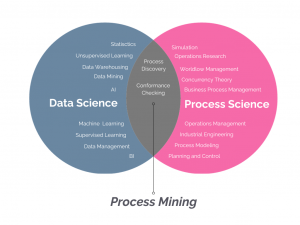Are you ready to transform your business operations from a tangle of spaghetti to a well-structured lasagna?
This isn’t about culinary skills, but a clever metaphor used by a renowned data science professor Wil van der Aalst in his book “Process Mining: Data Science in action” to illustrate the power of Process Mining. Welcome to the world of Process Mining, a potent tool that, much like a skilled chef, can transform the hidden tangles in your business operations into streamlined, efficient processes. But what exactly is Process Mining? And how can it turn your business from a chaotic “spaghetti” of hard-to-follow processes, into a “lasagna” – a well-structured, layered, and efficient workflow?
Unveiling Process Mining
Process Mining is a transformative technology and analytical discipline that provides a deep-dive into your business operations. At its core, it’s a form of data analysis. Still, it’s not just about the data—it’s about the fresh perspective that the data provides as it draws back the curtain on your processes, revealing areas of inefficiency, bottlenecks, and opportunities for improvement. It uses event logs to create a visual representation of a process, allowing businesses to understand and improve their workflows like never before.

Process Mining as the Intersection Between Data Science and Process Science
There are 3 main types of process mining analysis:
- Discovery: This method models the as-is process from scratch, revealing ad-hoc processes and handling different types of flows. It generates a model from an event log without extra information.
- Conformance: Also known as compliance, this approach compares the event log of reality to a predefined normative process model, aiding businesses in enhancing compliance by checking for deviations and violations.
- Enhancement: This technique aims to improve the existing process model using data from the event log, aligning areas that don’t match perfectly.
Life Cycle of a Process Mining Project: The Journey from Spaghetti to Lasagna
The primary objectives of Process Mining technology are the visual representation of complex processes and the usability and ease of understanding of the obtained model. In the real world, the complexity of a process structure varies. On one end of the spectrum, we have “Lasagna” processes—highly structured workflows where the paths are well defined, with few and well-controlled variants.

Lasagna Process
While “Spaghetti” processes may seem to offer flexibility, they can lead to inefficiencies, errors, and confusion due to their lack of structure and control. The multiple, uncontrolled variants in these processes can result in inconsistencies in execution, making it difficult to identify issues and implement improvements.

Spaghetti Process
Process Mining aims to transform your Spaghetti processes into Lasagna processes. The goal is to turn those complex, hard-to-follow workflows into structured, layered, and easy-to-understand processes.
An excellent example of this transformation comes from the financial services industry as AIG utilized process mining to streamline their operations. Initially, they had a complex process that took 12 days to complete. With the help of process mining, they managed to reduce the cycle time to just 5 days, thereby increasing the throughput by over 30%.
The benefits of applying process mining techniques are manifold. They not only help in identifying bottlenecks and inefficiencies in existing processes but also aid in streamlining operations, reducing cycle times, and increasing throughput. In addition, process mining can provide insights into process compliance issues, enabling organizations to enhance their regulatory adherence and decrease the risk of non-compliance. These benefits collectively lead to improved service delivery, better customer experience, and ultimately, increased business value.
Conclusion: Lasagna or Spaghetti?
Process mining technology is not just an emerging field—it’s a game-changer with the potential to revolutionize process management.
At Making Science, we’re not just experts—we’re your partners in transformation. From assessments to identifying optimization potential, building event data pipelines, process modeling, and monitoring, we offer comprehensive services encompassing process auditing and the implementation of recommendations.
Let’s connect and uncover the opportunities process mining could bring to your IT workflows. Choose clarity. Choose efficiency. Choose lasagna!








 Cookie configuration
Cookie configuration